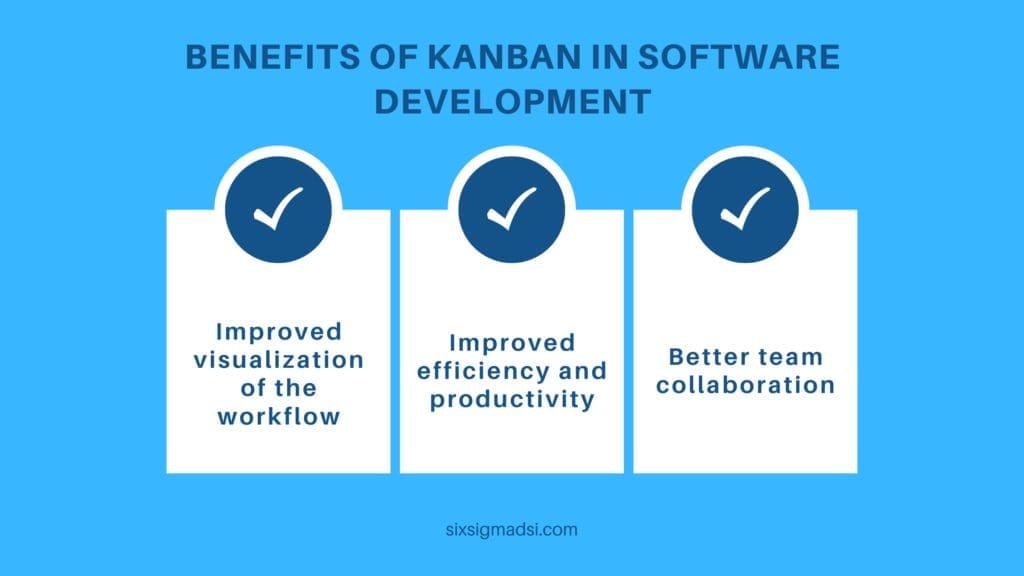Table of contents
Kanban in Software Development
A Kanban board is an important tool in software development because it helps teams to visualize and manage the flow of work, prioritize tasks, and improve efficiency and productivity.
In software development, Kanban can be used to manage the flow of tasks and issues from development to testing to deployment. It can help teams to identify and address bottlenecks in the workflow, and it allows for flexible and adaptive planning, as tasks can be easily moved and reprioritized.
Kanban boards in Jira, for example, provide a visual representation of the workflow, making it easy to see the progress and status of tasks, which helps team members to better understand where they are in the process and what they need to do next.
Additionally, Kanban’s focus on a “pull” system, where work is pulled through the process only when there is capacity, can help teams to limit work in progress and prioritize their efforts, which leads to improved efficiency and productivity.
Kanban also allows for continuous integration and delivery of new features, which can help teams to deliver software faster and more frequently, which can be especially beneficial for teams that are focused on delivering software as a service.
Overall, Kanban is an important tool for software development teams because it helps them to visualize and manage the flow of work, prioritize tasks, and improve efficiency and productivity, which leads to faster delivery of software and better customer satisfaction.
What is Kanban?
Kanban is a method of managing and visualizing work as it moves through a process. It is focused on visualizing and limiting work in progress, and it is commonly used in manufacturing and service industries. It was originally developed by Taiichi Ohno as a method for improving efficiency at Toyota manufacturing plants in the 1940s. The term “Kanban” is Japanese for “signboard” or “billboard.”
In software development, Kanban boards are used to visualize the flow of work, identify bottlenecks, and optimize flow. Tasks and issues are represented as cards on the board and moved through various stages of processing, such as “to do,” “in progress,” and “done.” The number of tasks or issues that can be in progress at any given time is limited, usually by a set number of “work in progress” (WIP) limits. This helps to ensure that teams are not overburdened with too much work and that tasks are completed in a timely manner.
Kanban can be used in conjunction with other methodologies such as Scrum, or it can be used as a standalone method. It is often used in software development, IT, marketing and other service industries, but it can be adapted for use in any process or industry.
Key Benefits of using Kanban in Software Development

There are several benefits of using Kanban in software development, including:
- Improved visualization of the workflow: Kanban boards provide a visual representation of the workflow, making it easy to see the progress and status of tasks. This can help teams to better understand where they are in the process and what they need to do next.
- Increased flexibility and adaptability: Kanban allows for flexible and adaptive planning, as tasks can be easily moved and reprioritized. This can be especially beneficial for teams that are working in an unpredictable or rapidly changing environment.
- Improved efficiency and productivity: Kanban’s focus on a “pull” system, where work is pulled through the process only when there is capacity, can help teams to limit work in progress and prioritize their efforts, which leads to improved efficiency and productivity.
- Better team collaboration: Kanban boards can be used to facilitate collaboration and communication within teams, as all members have a clear understanding of the workflow and the progress of tasks.
- Reduced lead time: By limiting work in progress, Kanban helps teams to focus on completing one task at a time which can lead to a reduction in lead time
- Improved customer satisfaction: Kanban allows for continuous integration and delivery of new features, which can help teams to deliver software faster and more frequently, which can lead to better customer satisfaction.
- Better ability to manage change: Kanban is an adaptive method and allows teams to respond to change in a more flexible way.
- Better metrics to measure performance: Kanban provides metrics like lead time, cycle time, WIP, etc which can be used to measure performance and optimize the process.
Overall, using Kanban in software development can provide teams with improved visibility, flexibility, and efficiency, leading to better collaboration, faster delivery, and better customer satisfaction.

Examples of using Kanban in Software Development
There are many ways that Kanban can be used in software development, but here are a few examples:
- Managing the development process: A Kanban board can be used to manage the flow of tasks and issues from development to testing to deployment. It can help teams to visualize the progress of tasks and issues and identify bottlenecks in the workflow.
- Prioritizing tasks: Kanban boards can be used to prioritize tasks based on their importance and urgency. By visualizing the flow of work, teams can easily see which tasks need to be completed first and which can be deferred.
- Managing a backlog: A Kanban board can be used to manage a backlog of tasks and issues, which can help teams to prioritize and plan their work more effectively.
- Managing multiple projects: A Kanban board can be used to manage multiple projects at once. By visualizing the flow of work across multiple projects, teams can more easily balance their workloads and ensure that all projects are moving forward.
- Managing customer service requests: In a customer service context, a Kanban board can be used to manage customer service requests, where each request is represented as a card on the board and moved through various stages of processing, such as assigned, in progress, and resolved.
- Managing maintenance tasks: A Kanban board can be used to manage maintenance tasks, where tasks are represented as cards on the board and moved through various stages of processing, such as assigned, in progress, and done.
Overall, Kanban can be used in many different ways in software development, the key is to understand the process and adapt the Kanban board to fit the specific needs of the team or organization.
Have you seen any benefits from implementing kanban in software development?
Let us know the benefits you’ve seen in the comments below!



















